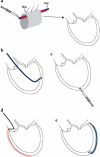Non-surgical stem cell delivery strategies and in vivo cell tracking to injured myocardium
- PMID: 20577813
- PMCID: PMC3092059
- DOI: 10.1007/s10554-010-9658-4
Non-surgical stem cell delivery strategies and in vivo cell tracking to injured myocardium
Abstract
Heart failure is a major economic and public health problem. Despite the recent advances in drug therapy and coronary revascularization, the lost cardiomyocytes due to necrosis and apoptosis are not replaced by new myocardial tissue. Cell therapy is an interesting therapeutic option as it potentially improves contractility and restores regional ventricular function. Early clinical data demonstrated that cell transplantation, mainly delivered through non-surgical methods, is safe and feasible. However, several important issues need to be elucidated. This includes, next to determining the best cell type, the optimal delivery strategy, the biodistribution and the survival of implanted stem cells after transplantation. In this view, pre-clinical animal experiments are indispensable. Reporter genes, magnetic or radioactive labeling of stem cells have been developed to observe the fate and the distribution of transplanted cells using non-invasive imaging techniques. Several studies have demonstrated that these direct and non-direct labeling techniques may become an important tool in cell therapy. Integration of cell delivery and cell tracking will probably be a key for the success of cell therapy in patients. This review will provide a comprehensive overview on the various cell tracking and non-surgical cell delivery techniques, which are highly important in view of experimental and clinical studies.
© The Author(s) 2010.
Figures




Similar articles
-
Cell delivery and tracking in post-myocardial infarction cardiac stem cell therapy: an introduction for clinical researchers.Heart Fail Rev. 2010 Jan;15(1):1-14. doi: 10.1007/s10741-009-9134-1. Heart Fail Rev. 2010. PMID: 19238541 Review.
-
Progress and Challenge of Cardiac Regeneration to Treat Heart Failure.J Cardiol. 2019 Feb;73(2):97-101. doi: 10.1016/j.jjcc.2018.10.002. Epub 2018 Nov 9. J Cardiol. 2019. PMID: 30420106 Review.
-
Spatiotemporal control of cell fate and cardiac differentiation.Annu Int Conf IEEE Eng Med Biol Soc. 2011;2011:5567-8. doi: 10.1109/IEMBS.2011.6091346. Annu Int Conf IEEE Eng Med Biol Soc. 2011. PMID: 22255600
-
Stem Cell and Left Ventricular Assist Device Combination Therapy.Circ Heart Fail. 2019 Feb;12(2):e005454. doi: 10.1161/CIRCHEARTFAILURE.118.005454. Circ Heart Fail. 2019. PMID: 30759999 Review.
-
Stimulating Cardiogenesis as a Treatment for Heart Failure.Circ Res. 2019 May 24;124(11):1647-1657. doi: 10.1161/CIRCRESAHA.118.313573. Circ Res. 2019. PMID: 31120819 Free PMC article. Review.
Cited by
-
An Injectable and Drug-loaded Supramolecular Hydrogel for Local Catheter Injection into the Pig Heart.J Vis Exp. 2015 Jun 7;(100):e52450. doi: 10.3791/52450. J Vis Exp. 2015. PMID: 26132631 Free PMC article.
-
Cardiovascular imaging 2011 in the International Journal of Cardiovascular Imaging.Int J Cardiovasc Imaging. 2012 Mar;28(3):439-51. doi: 10.1007/s10554-012-0040-6. Int J Cardiovasc Imaging. 2012. PMID: 22476909 Free PMC article. Review. No abstract available.
-
Imaging cardiac stem cell therapy: translations to human clinical studies.J Cardiovasc Transl Res. 2011 Aug;4(4):514-22. doi: 10.1007/s12265-011-9281-3. Epub 2011 May 3. J Cardiovasc Transl Res. 2011. PMID: 21538182 Free PMC article. Review.
-
Will mesenchymal stem cells be future directions for treating radiation-induced skin injury?Stem Cell Res Ther. 2021 Mar 12;12(1):179. doi: 10.1186/s13287-021-02261-5. Stem Cell Res Ther. 2021. PMID: 33712078 Free PMC article. Review.
-
Tracking of stem cells in vivo for cardiovascular applications.J Cardiovasc Magn Reson. 2014 Jan 10;16(1):7. doi: 10.1186/1532-429X-16-7. J Cardiovasc Magn Reson. 2014. PMID: 24406054 Free PMC article. Review.
References
-
- Rosamond W, Flegal K, Furie K, Go A, Greenlund K, Haase N, Hailpern SM, Ho M, Howard V, Kissela B, Kittner S, Lloyd-Jones D, McDermott M, Meigs J, Moy C, Nichol G, O’Donnell C, Roger V, Sorlie P, Steinberger J, Thom T, Wilson M, Hong Y, for the American Heart Association Statistics Committee, Stroke Statistics Subcommittee Heart disease and stroke statistics—2008 update: a report from the American Heart Association Statistics Committee and Stroke Statistics Subcommittee. Circulation. 2008;117:e25–146. doi: 10.1161/CIRCULATIONAHA.107.187998. - DOI - PubMed
-
- World Health Organization (2007) The atlas of heart disease and stroke. pp 48–49
-
- Halkos M, Zhao ZQ, Kerendi F, Wang NP, Jiang R, Schmarkey L, Martin B, Quyyumi A, Few W, Kin H, Guyton R, Vinten-Johansen J. Intravenous infusion of mesenchymal stem cells enhances regional perfusion and improves ventricular function in a porcine model of myocardial infarction. Basic Res Cardiol. 2008;103:525–536. doi: 10.1007/s00395-008-0741-0. - DOI - PubMed
-
- Hare JM, Traverse JH, Henry TD, Dib N, Strumpf RK, Schulman SP, Gerstenblith G, DeMaria AN, Denktas AE, Gammon RS, Hermiller JB, Jr, Reisman MA, Schaer GL, Sherman W. A randomized, double-blind, placebo-controlled, dose-escalation study of intravenous adult human mesenchymal stem cells (prochymal) after acute myocardial infarction. J Am Coll Cardiol. 2009;54:2277–2286. doi: 10.1016/j.jacc.2009.06.055. - DOI - PMC - PubMed
-
- Perin EC, Dohmann HFR, Borojevic R, Silva SA, Sousa ALS, Mesquita CT, Rossi MID, Carvalho AC, Dutra HS, Dohmann HJF, Silva GV, Belem L, Vivacqua R, Rangel FOD, Esporcatte R, Geng YJ, Vaughn WK, Assad JAR, Mesquita ET, Willerson JT. Transendocardial, autologous bone marrow cell transplantation for severe, chronic ischemic heart failure. Circulation. 2003;107:2294–2302. doi: 10.1161/01.CIR.0000070596.30552.8B. - DOI - PubMed
Publication types
MeSH terms
LinkOut - more resources
Full Text Sources
Medical

